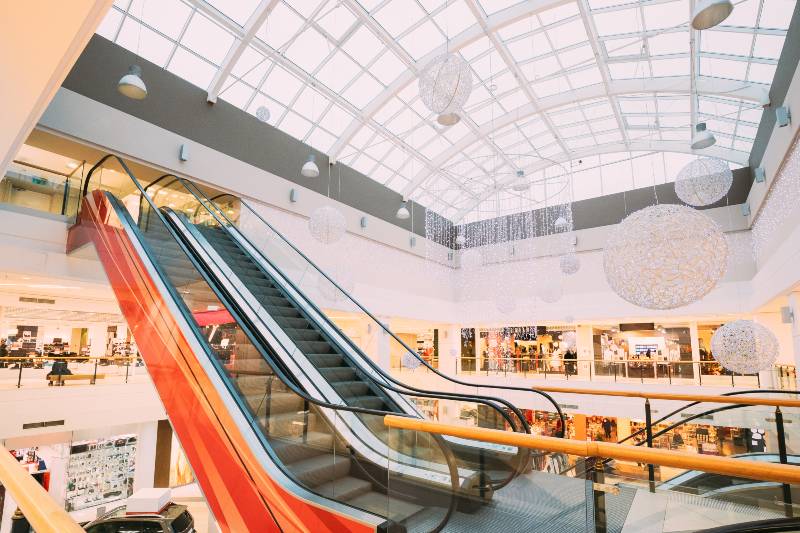For the past few decades, malls have been go-to destinations for all of our shopping needs. From apparel to electronics, we’ve come to rely on traditional brick-and-mortar stores as our primary source of consumer goods. But with the rise of e-commerce platforms such as Amazon dominating retail space, many are starting to question what impact this shift will have on the future of malls. What can mall owners do to ensure their place in an age where most transactions are digital? In this blog post, we’ll look at how malls can continue to be relevant and successful despite these trends.
In the e-commerce era, malls are transforming from mere shopping destinations to experiential hubs, integrating entertainment and digital conveniences. As they merge online and offline experiences, malls evolve, fostering a symbiotic relationship with e-commerce, and harnessing tech innovations to remain relevant and vital in the modern retail landscape.
Key Takeaways
- Malls are no longer just shopping destinations; they’re evolving into experiential hubs offering dining, entertainment, and more, making them relevant in the e-commerce age.
- Malls and e-commerce aren’t necessarily adversaries. Successful malls are finding ways to integrate online and offline shopping experiences, benefiting both sectors.
- The future of malls hinges on their ability to adopt new technologies (like VR and AR) and transform based on changing consumer preferences and the evolving digital landscape.

Factors Leading to the Decline of Traditional Malls
The convenience of online shopping:
In today’s digital age, the sheer convenience of online shopping has significantly contributed to the decline of traditional malls.
With just a few clicks, consumers can browse an almost infinite variety of products, read reviews, and have their chosen items delivered straight to their doorsteps, sometimes within hours. Take, for instance, the rise of e-commerce giants like Amazon and Alibaba.
Why would someone drive to a mall, search for a parking spot, and walk through several stores to find a particular item when they could simply type in what they’re looking for and have it appear on their screen within seconds?
Online shopping has not only provided a wide range of product choices but also offered the luxury of shopping without the constraints of store hours or geographical boundaries.
The global pandemic and its influence
The COVID-19 pandemic, which struck the world in late 2019 and continued for years, dealt a substantial blow to traditional shopping malls. As governments across the globe imposed lockdowns and restricted movements to curb the virus’s spread, malls were forced to shut their doors.
Even when they reopened, many consumers remained wary of crowded places. Think about the ambiance of a typical mall during holiday sales – bustling crowds, children playing, and long lines at checkout counters.
This image became daunting in a post-pandemic world, where people prioritized health and safety over the mall experience.
Furthermore, during the pandemic, even those who previously preferred brick-and-mortar stores had little choice but to adapt to online shopping, leading to a lasting shift in buying habits for many.
Changing consumer preferences
As the years have gone by, consumers have evolved in their preferences, seeking experiences rather than just products. Malls, which once were the epicenters of social gatherings and leisurely shopping, began to feel monotonous.
Consumers started gravitating towards unique, localized experiences, like farmers’ markets, boutique stores, department stores, or pop-up shops that offered a distinct feel and personalized service. Take the example of a millennial shopper.
Instead of buying a mass-produced shirt from a big chain store in a mall, they might prefer a handcrafted one from a local designer, which tells a story and connects with their values.
Moreover, the rise of “fast fashion” online retailers and direct-to-consumer brands further dented the allure of malls, as these platforms continuously adapted to rapidly changing fashion trends, offering fresh, affordable, and trendy choices.
While the decline of traditional malls can be attributed to various reasons, the allure of online shopping’s convenience, the profound impact of a global pandemic, and evolving consumer tastes have played pivotal roles. As consumers continue to seek value, safety, and unique experiences, malls will need to reimagine their offerings to remain relevant in this ever-changing landscape.
The Evolution of Malls
The world has always been a place of constant change, and the retail landscape is no exception. Malls, those sprawling epicenters of commerce, have notably evolved over the years, morphing to meet the changing demands and preferences of consumers.
Let’s delve into how these giants of retail have transformed, ensuring they remain not just relevant but also essential in our lives.
Transformation into experiential centers:
Gone are the days when malls were merely clusters of stores where you’d dash in, make a purchase, and leave. Today, the modern mall is designed to offer an immersive experience. This transformation into experiential centers is rooted in the idea that shopping is no longer just a transactional activity.
People now seek holistic experiences that engage their senses, emotions, and desires. For instance, you might come across art installations, interactive displays, or even workshops and classes being conducted within mall premises.
These offer patrons a chance not just to shop but to learn, engage, and create memories.
Imagine attending a pottery class in the same place you went shoe shopping or stumbling upon a live jazz band performance as you move from one store to the next. The mall becomes a destination, not just a pitstop.
2. Incorporation of entertainment, dining, and leisure activities
One of the most significant shifts in mall evolution has been the robust inclusion of entertainment, dining, and leisure zones. While earlier malls had maybe a movie theater and a basic food court, today’s malls are home to gourmet restaurants, expansive multiplexes, indoor amusement parks, gymnasiums, and even skating rinks or aquariums in some cases.
The idea is to make the mall a one-stop destination for all family members. Consider it this way: parents can enjoy a fine-dining experience, children can revel in an indoor theme park, while grandparents relax in a serene lounge or garden space, all under one roof.
This multi-dimensional approach ensures prolonged footfall and varied engagement.
3. Integration with e-commerce through “click and collect” services
Recognizing the undeniable pull of e-commerce, malls have begun to integrate online shopping into their model.
The ‘click and collect’ service is a prime example. Customers can browse and buy products online but pick them up at the physical mall store, blending the convenience of online shopping with the immediacy of offline collection. It’s like reserving your favorite pair of shoes online and then trying them on and picking them up at the store in the mall later that day.
Such integrations not only offer consumers flexibility but also drive them back to physical retail, increasing the chances of spontaneous purchases and further engagement.
Success Stories: Malls That Pivoted
In the face of shifting retail landscapes and evolving consumer preferences, many malls found themselves on the brink of irrelevance. However, some visionary malls identified these challenges as opportunities and successfully pivoted to stay ahead of the curve. Let’s delve into a few case studies of malls that reinvented themselves, blending online and offline shopping experiences to thrive in the digital age.
1. The Mall of America, Minnesota
As the largest shopping mall in the U.S., the Mall of America is a testament to how large-scale retail spaces can remain relevant by continually adapting.
Beyond its vast array of shops, the mall boasts an indoor amusement park, aquarium, and even wedding chapels.
Recognizing the surge in online shopping, the Mall of America integrated digital storefronts for its retailers, allowing visitors to scan QR codes, view products, and make purchases online to be shipped home, thus blending the tactile experience of in-mall shopping with the convenience of e-commerce.
2. Westfield, Worldwide
Westfield, a global shopping center operator with locations in the U.S., U.K., and Australia, has actively embraced the digital revolution.
They introduced “Westfield Direct,” a drive-through click and collect service allowing customers to order from multiple retailers within the mall online and then pick up all items at a designated drive-through point.
This integration ensures customers get the convenience of online shopping while still driving foot traffic (or in this case, car traffic) to the mall’s premises.
3. The Dubai Mall, UAE:
As one of the world’s largest malls, the Dubai Mall is no stranger to innovation. In response to the growing e-commerce trend, the mall introduced a virtual store, “The Dubai Mall Virtual Store,” allowing consumers to shop from various retailers online.
To enhance this, they created a seamless returns process where shoppers could return online purchases directly at the mall.
Additionally, the mall hosts several events, pop-up installations, and entertainment options, ensuring it’s not just a shopping destination but a holistic experience center.
4. Easton Town Center, Ohio
This mall embraced the trend of experiential shopping by transforming parts of its space into a “lifestyle center.” Beyond retail, they integrated offices, residential spaces, and a wide range of dining and entertainment options.
They’ve also incorporated digital touchpoints, offering apps and online platforms where visitors can view events, book experiences, and even shop from select retailers.
The blend of work, life, and play has made it a thriving community hub, not just a shopping center.
5. Plaza Singapura, Singapore
In the heart of Singapore’s shopping district, this mall took a proactive approach by introducing a “click and collect” lounge. Shoppers can order from various mall retailers online and then conveniently collect their purchases from a centralized lounge. The mall further enhances the offline shopping experience by regularly hosting thematic events, pop-up markets, and interactive installations.
Challenges Still Faced by Malls
While many malls have shown remarkable adaptability and resilience in the changing retail landscape, they continue to grapple with a myriad of challenges. Here are some of the significant hurdles they still confront:
1. Rent and property prices
Real estate dynamics play a significant role in the challenges faced by malls. Rising property prices mean that mall operators often need to charge higher rents to stay profitable. For retailers, these escalating rents can be burdensome, especially when sales are not proportionally increasing.
This is particularly noticeable in prime urban and suburban societies locations where property prices have skyrocketed.
For instance, a boutique store may struggle to afford the monthly rent in a prime mall location, leading to more vacancies and a potential downturn in the mall’s appeal. High rents can also deter innovative or newer businesses, which might have otherwise added a fresh flavor to the mall’s offerings, from setting up shop.
2. Competition with purely online marketplaces
E-commerce giants like Amazon, Alibaba, and eBay have transformed the way people shop. The convenience, variety, and often lower prices available on these platforms make them formidable competitors to traditional malls.
Think of the sheer variety: Why would someone wait for a specific item to stock up in a local mall when they can find it online with express shipping? The overhead costs for purely online marketplaces are also often lower than brick-and-mortar stores, enabling them to offer competitive prices.
Moreover, online sales events, like Black Friday deals or Amazon’s Prime Day, continue to attract massive attention, further diverting potential customers from malls.
3. Keeping up with technological advancements
The pace at which technology evolves poses a challenge for malls that strive to stay contemporary. Implementing and maintaining state-of-the-art infrastructure, from digital payment solutions to augmented reality fitting rooms, requires significant investment.
There’s also the need for consistent technological updates and the pressure to continually innovate to match or surpass online shopping experiences.
For instance, while a mall might introduce a mobile app to enhance the shopping experience, they need to ensure regular updates, maintain cybersecurity standards, and ensure the app offers real value to consumers.
Beyond this, there’s the challenge of training staff to utilize these technologies effectively and ensuring seamless integration between online and offline touchpoints.
The Potential Future of Malls
As we gaze into the future of malls, it’s evident that these spaces will need to undergo further evolution to remain relevant and appealing. Here’s a speculative glimpse into the potential trajectory malls might take:
1. Embracing technology: VR, AR, and other tech integrations
- Virtual Reality (VR) Shopping: The concept of VR shopping could become mainstream. Imagine wearing VR goggles and walking through a virtual mall from the comfort of your home. You could browse items, “try them on,” and even experience the ambiance of a mall, all virtually. This could merge the experiential benefits of in-person shopping with the convenience of online shopping.
- Augmented Reality (AR) Experiences: AR could enhance in-mall experiences. Shoppers might use their smartphones or AR glasses to get instant product information, visualize products in different colors or styles, or even navigate the mall. Imagine pointing your device at a shirt and seeing how it might look in a different color or getting a virtual map overlay showing you the quickest route to your favorite store.
2. Malls as community hubs
- Co-working Spaces: With the rise of remote work and freelancing, malls could incorporate co-working spaces, allowing professionals to work, meet, and collaborate. Picture completing a work project and then stepping out into the mall for a quick shopping spree or a meal.
- Educational and Skill Centers: Malls could house educational workshops, classes, or even mini-courses on various topics, turning them into centers of learning and skill acquisition.
- Recreation and Fitness: Beyond shopping and dining, malls could offer yoga classes, fitness centers, meditation zones, and other health-focused amenities, drawing in a regular crowd.
3. Sustainability and eco-friendly practices
- Green Architecture: Future malls could be designed or retrofitted with sustainability in mind, incorporating features like green roofs, rainwater harvesting systems, and natural ventilation techniques.
- Eco-Friendly Retail: We might see more stores dedicated to sustainable, ethically produced, or upcycled products. These stores would cater to an increasingly eco-conscious consumer base.
- Waste Management and Reduction: Malls could introduce comprehensive recycling programs, zero-waste food courts, and initiatives to reduce single-use plastics. Consider a food court where everything, from cutlery to containers, is biodegradable or reusable.

The Future of Malls in the E-commerce Age FAQs
What is the significance of experiential shopping centers?
Experiential shopping centers are designed to appeal to shoppers’ senses, creating a unique and memorable experience. These spaces often incorporate features like interactive displays, live entertainment, or virtual reality experiences to create an immersive environment.
How are technological advancements like VR and AR being utilized in malls?
Technology like VR and AR can be used to enhance the shopping experience in malls. For example, shoppers might use AR to visualize product colors or styles or explore a virtual map of the mall. VR could also allow customers to virtually explore a mall from home.
What challenges are modern malls still facing?
Modern malls are facing challenges like competition from online marketplaces, the need to keep up with technological advancements, and the need to create a unique shopping experience. While some of these problems can be addressed through technology integrations and creative marketing strategies, only time will tell if malls can successfully compete with e-commerce platforms.
Can malls and e-commerce platforms coexist profitably?
Yes, malls and e-commerce platforms can coexist profitably. Malls offer an immersive shopping experience that online marketplaces cannot replicate. Additionally, brick-and-mortar stores have the potential to drive higher sales per square foot than their digital counterparts.
How is sustainability influencing the future of malls?
Malls have a responsibility to reduce their environmental impact and minimize their carbon footprint. The future of malls might involve green architecture, eco-friendly retail stores, and waste management initiatives. Such strategies could help drive customer loyalty and contribute to the long-term success of these spaces.
Read on here to know more about Sustainable Property Management: A Guide to Sustainable Property Management for Investors and Owners.
Property owners and investors have an important role to play when it comes to sustainability. Sustainable property management involves strategies such as improving energy efficiency, reducing waste, conserving resources, and utilizing renewable energy sources. By implementing these activities, landlords can reduce their environmental impact while also saving money in the long run.
Conclusion
With the e-commerce movement revolutionizing the shopping industry, malls are having to get creative to remain relevant and engage customers. Mall owners need to be willing to adapt and embrace new technologies while developing innovative experiential components that will draw people in. Malls are indeed in an interesting period where they must evolve or face extinction.
Perhaps most importantly though, mall owners must understand that e-commerce doesn’t necessarily mean the death of bricks-and-mortar stores – understanding how to successfully integrate both realms can create a great imperative where both benefit from each other.
Ultimately, there is potential for very meaningful experiences at the mall when handled with creativity and a focus on technology offered by retailers.
If you’re a real estate investor thinking about jumping into the mall game, don’t hesitate to reach out for help. Call or schedule a free consultation with me, a real estate professional who knows firsthand what it takes for malls to become successful hubs and popular destinations during the ever-evolving e-commerce age!



